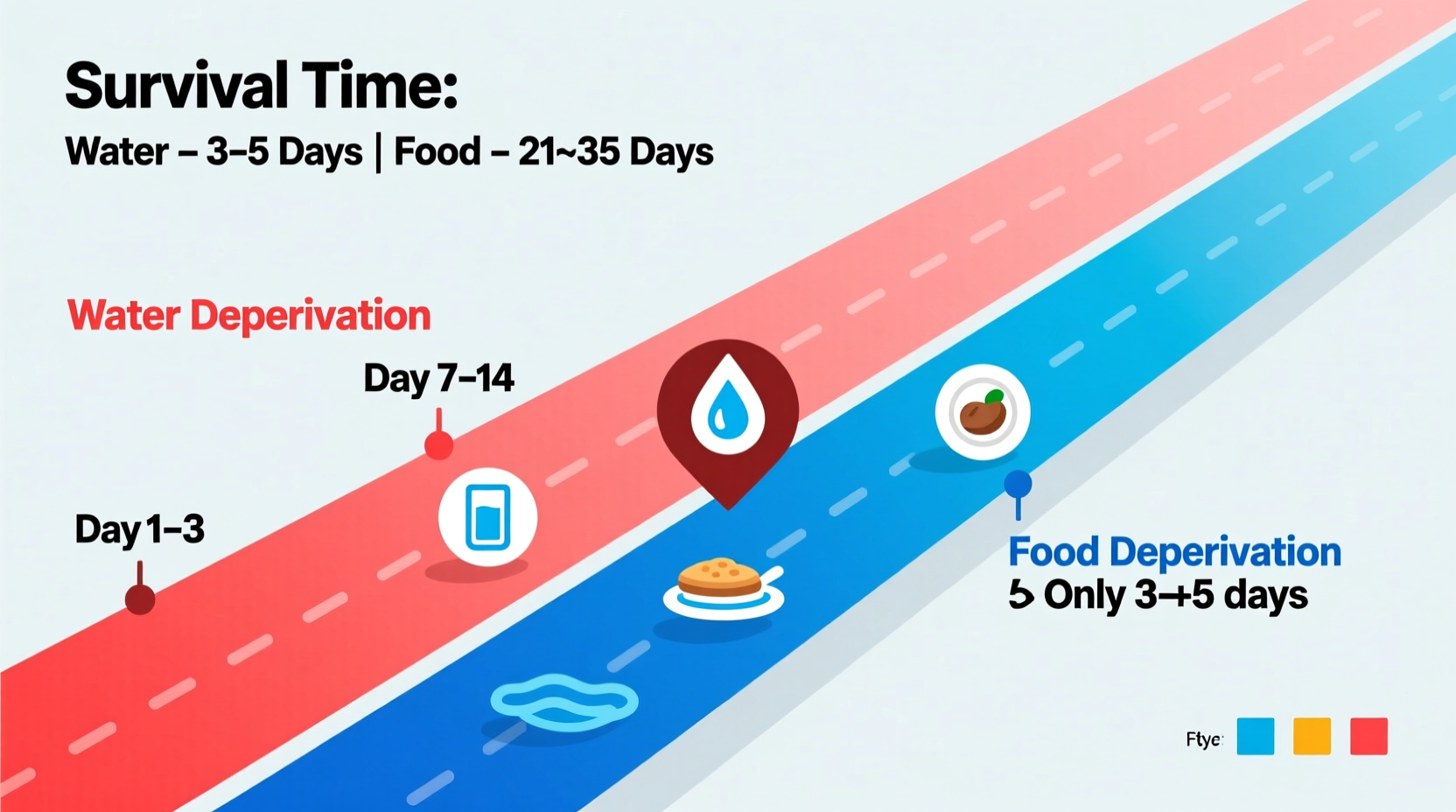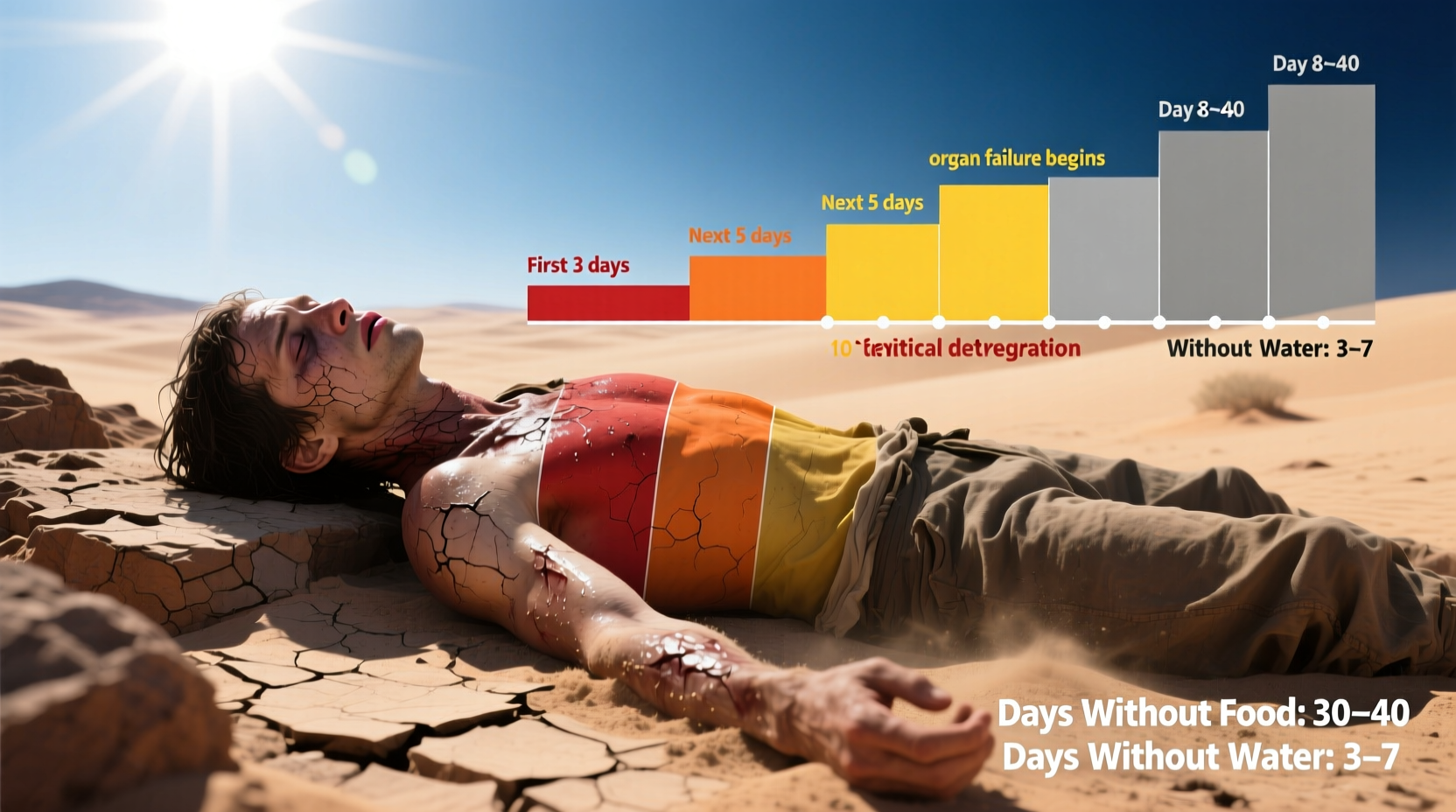Humans can typically survive approximately 3 weeks without food but only 3-4 days without water. These timelines vary significantly based on environmental conditions, individual health status, body composition, and activity levels. Medical experts confirm that water deprivation poses a more immediate threat to survival than food deprivation.
Understanding human survival limits isn't just theoretical knowledge—it's potentially life-saving information for emergency preparedness, wilderness adventures, or medical situations. Whether you're planning a hiking trip, concerned about disaster readiness, or simply curious about human physiology, knowing these critical timelines and the factors that influence them can make a crucial difference.
The Immediate Threat: Survival Without Water
Water constitutes about 60% of the human body and is essential for nearly every bodily function. Without adequate hydration, critical systems begin failing within hours. According to the Centers for Disease Control and Prevention, the average person can only survive 3-4 days without water under typical conditions.
Here's what happens during dehydration:
- First 24 hours: Mild dehydration begins with thirst, dry mouth, and reduced urine output
- 48 hours: Cognitive function declines, headaches develop, and physical performance drops significantly
- 72 hours: Organ systems start failing—kidneys reduce function, blood thickens, and body temperature regulation becomes impaired
- 96 hours: Severe dehydration leads to organ failure, loss of consciousness, and ultimately death
| Dehydration Stage | Time Without Water | Physical Symptoms | Critical Risks |
|---|---|---|---|
| Mild | 12-24 hours | Thirst, dry mouth, reduced urine | Reversible with hydration |
| Moderate | 24-48 hours | Headache, dizziness, fatigue | Impaired decision-making |
| Severe | 48-72 hours | Confusion, rapid heartbeat, no urine | Organ damage begins |
| Critical | 72+ hours | Loss of consciousness, organ failure | Life-threatening condition |
Surviving Without Food: The Longer Timeline
While water is immediately critical, humans can survive significantly longer without food—typically 3 weeks or more. The Mayo Clinic explains that the body enters survival mode, gradually shifting through metabolic phases to preserve essential functions.
The starvation process follows this progression:
- First 24-48 hours: The body depletes glycogen stores in liver and muscles
- Days 3-7: Metabolism shifts to ketosis, burning fat reserves for energy
- Weeks 2-3: The body begins breaking down muscle tissue for protein
- Beyond 3 weeks: Critical organ function deteriorates as the body consumes its own tissues
Individual survival time without food varies dramatically based on starting body fat percentage. People with higher body fat can survive longer as their bodies have more energy reserves to draw from. A comprehensive study published in the American Journal of Clinical Nutrition documented cases where individuals survived 40-70 days without food when properly hydrated.
Key Factors That Dramatically Affect Survival Time
Several critical variables can shorten or extend these survival timelines significantly:
Environmental Conditions
Extreme temperatures drastically impact survival odds. In hot environments (above 90°F/32°C), water loss accelerates through sweating, potentially reducing survival time to just 2-3 days. Conversely, in cold environments, the body expends more energy to maintain temperature, increasing caloric needs while potentially reducing water requirements.
Individual Health Factors
Pre-existing medical conditions significantly affect survival capacity. People with diabetes, kidney disease, or cardiovascular conditions may face more rapid deterioration. Age also plays a critical role—children and elderly individuals generally have reduced survival windows due to less physiological reserve.
Activity Level
Physical exertion dramatically increases both water and caloric needs. Someone hiking in desert conditions might survive only 1-2 days without water, while a person resting in shade might last 4-5 days. The Scientific Reports journal documented cases where survival time decreased by 40-60% with moderate physical activity in hot conditions.

Recognizing Dangerous Warning Signs
Knowing the progression of symptoms can help identify when emergency intervention is needed:
Dehydration Warning Signs
- Dark yellow or amber-colored urine (beyond first morning void)
- Dry skin that doesn't bounce back when pinched (skin turgor test)
- Dizziness when standing (orthostatic hypotension)
- Confusion or disorientation
- Rapid heart rate with weak pulse
Starvation Warning Signs
- Extreme fatigue and weakness
- Constant hunger followed by loss of appetite
- Difficulty concentrating and memory problems
- Cold intolerance (feeling cold constantly)
- Edema (swelling in extremities) in later stages
Practical Survival Strategies
If facing potential food or water deprivation, these evidence-based strategies can extend your survival window:
Water Conservation Techniques
- Stay in shade and minimize physical activity during peak heat hours
- Breathe through your nose to reduce moisture loss
- Avoid eating if water is scarce (digestion requires water)
- Use available materials to collect dew or condensation
Food Deprivation Management
- Conserve energy by resting as much as possible
- Focus on finding water first—survival without water is measured in days, not weeks
- If foraging, prioritize identifying safe water sources over food sources
- When breaking a fast, start with small amounts of easily digestible foods
Remember that psychological factors significantly impact survival. Maintaining hope, staying mentally active, and having a clear plan can extend survival time beyond what physical metrics might suggest. Research from survival psychology studies shows that mental resilience can extend survival time by 20-30% compared to those who lose hope.
When Medical Intervention Becomes Critical
After extended periods without food or water, rehydration and refeeding require medical supervision. The National Institutes of Health warns that refeeding syndrome—a potentially fatal condition caused by rapid reintroduction of nutrients—can occur when food is consumed too quickly after prolonged starvation. Similarly, rapid rehydration after severe dehydration can cause dangerous electrolyte imbalances.
If someone has been without water for more than 3 days or without food for more than 2 weeks, seek immediate medical attention before attempting to provide food or water. Medical professionals can safely manage the rehydration and refeeding process to prevent complications.
Final Thoughts on Human Survival Limits
While the general timelines of 3-4 days without water and 3 weeks without food provide a useful framework, real-world survival depends on numerous interacting factors. Understanding these variables helps move beyond simplistic timelines to practical knowledge that could save your life or someone else's in an emergency situation.
Preparation remains your best defense—carrying emergency water purification tools, knowing basic survival techniques, and understanding your body's warning signs significantly increase your chances in unexpected situations. The human body is remarkably resilient, but it has clear limits that we must respect and understand.
Can you survive longer without food than water?
Yes, humans typically survive about 3 weeks without food but only 3-4 days without water. Water is essential for immediate bodily functions, while the body can draw on fat and muscle reserves for energy when food is unavailable.
What factors shorten survival time without water?
High temperatures, physical exertion, pre-existing medical conditions, and low body fat percentage all significantly reduce survival time without water. In extreme heat with activity, survival may be limited to just 1-2 days.
How can I tell if I'm becoming dangerously dehydrated?
Key signs include dark yellow urine, dry mouth, dizziness when standing, reduced urine output, rapid heartbeat, and confusion. If you experience confusion or dizziness, seek water immediately as these indicate severe dehydration.
What should I do after finding water following dehydration?
Sip water slowly rather than drinking large amounts at once. Rapid rehydration can cause dangerous electrolyte imbalances. If severely dehydrated (beyond 3 days), seek medical attention before rehydrating as professional monitoring may be necessary.
Is it safe to drink small amounts of urine in survival situations?
No, medical experts strongly advise against drinking urine. It concentrates toxins and salts your body is trying to eliminate, accelerating dehydration and potentially causing kidney damage. Focus on finding clean water sources instead.











 浙公网安备
33010002000092号
浙公网安备
33010002000092号 浙B2-20120091-4
浙B2-20120091-4